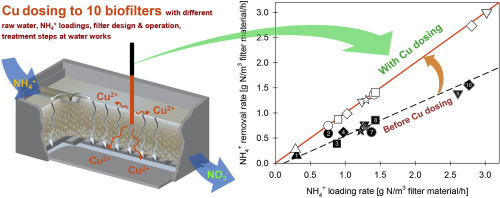Water Research ( IF 11.4 ) Pub Date : 2017-12-27 , DOI: 10.1016/j.watres.2017.12.061 Florian B. Wagner , Peter Borch Nielsen , Rasmus Boe-Hansen , Hans-Jørgen Albrechtsen

|
Drinking water treatment plants based on groundwater may suffer from incomplete ammonium removal, which deteriorates drinking water quality and constrains water utilities in the operation of their plants. Ammonium is normally removed through nitrification in biological granular media filters, and recent studies have demonstrated that dosing of copper can stimulate the removal of ammonium. Here, we investigated if copper dosing could generically improve ammonium removal of biofilters, at treatment plants with different characteristics. Copper was dosed at ≤1.5 μg Cu/L to biofilters at 10 groundwater treatment plants, all of which had displayed several years of incomplete nitrification. Plants exceeded the Danish national water quality standard of 0.05 mg NH4+/L by a factor of 2–12. Within only 2-3 weeks of dosing, ammonium removal rates increased significantly (up to 150%). Nitrification was fully established, with ammonium effluent concentrations of <0.01 mg NH4+-N/L at most plants, regardless of the differences in raw water chemistry, ammonium loading rates, filter design and operation, or treatment plant configuration. However, for filters without primary filtration, it took longer time to reach complete ammonium removal than for filters receiving prefiltered water, likely due to sorption of copper to iron oxides, at plants without prefiltration. With complete ammonium removal, we subjected two plants to short-term loading rate upshifts, to examine the filters' ability to cope with loading rate variations. After 2 months of dosing and an average loading rate of 1.0 g NH4+-N/m3 filter material/h, the loading rate was upshifted by 50%. Yet, a filter managed to completely remove all the influent ammonium, showing that with copper dosing the filter had extra capacity to remove ammonium even beyond its normal loading rates. Depth sampling revealed that the ammonium removal rate of the filter's upper 10 cm increased more than 7-fold from 0.67 to 4.90 g NH4+-N/m3/h, and that nitrite produced from increased ammonium oxidation was completely oxidized further to nitrate. Hence, no problems with nitrite accumulation or breakthrough occurred. Overall, copper dosing generically enhanced nitrification efficiency and allowed a range of quite different plants to meet water quality standards, even at increased loading rates. The capacity increase is highly relevant in practice, as it makes filters more robust towards sudden ammonium loading rate variations.
中文翻译:

通过铜计量修复不同饮用水处理厂的不完全硝化和提高生物滤池的容量
基于地下水的饮用水处理厂可能会遭受铵去除不完全的困扰,这会降低饮用水质量并限制其工厂运营中的用水。通常通过生物颗粒介质过滤器中的硝化作用去除铵,最近的研究表明铜的投加可以刺激铵的去除。在这里,我们研究了在具有不同特性的处理厂中,铜的投加是否能普遍改善生物滤池的铵去除率。在10个地下水处理厂的生物滤池中,铜的计量浓度为≤1.5μgCu / L,所有这些都显示出了几年的不完全硝化作用。植物超过了丹麦国家水质标准0.05毫克的NH 4 +/ L乘以2-12。在给药的仅2-3周内,铵去除率显着提高(高达150%)。硝化作用已完全建立,氨气出水浓度<0.01 mg NH 4 +-在大多数工厂中为-N / L,无论原水化学性质,铵负载率,过滤器的设计和运行或处理厂配置的差异如何。但是,对于没有进行初滤的过滤器,要达到完全去除铵的时间要比接受预过滤水的过滤器要花费更长的时间,这可能是由于未经预过滤的工厂将铜吸附到氧化铁上造成的。完全去除铵后,我们对两家工厂进行了短期负荷率上调,以检查过滤器应对负荷率变化的能力。给药2个月后,平均加载速率为1.0 g NH 4 + -N / m 3过滤材料/小时,加载速率提高了50%。然而,过滤器设法完全去除了所有流入的铵,这表明通过铜计量,过滤器具有甚至超过其正常负载率的去除铵的额外能力。深度采样表明,过滤器上部10 cm的铵去除率从0.67到4.90 g NH 4 + -N / m 3增加了7倍以上。/ h,并且由增加的铵氧化产生的亚硝酸盐进一步被完全氧化成硝酸盐。因此,没有发生亚硝酸盐积累或突破的问题。总体而言,铜的投加通常提高了硝化效率,即使在增加负荷的情况下,也允许一系列完全不同的工厂达到水质标准。在实践中,容量增加与高度相关,因为它使过滤器对突然的铵负载速率变化更加坚固。











































 京公网安备 11010802027423号
京公网安备 11010802027423号